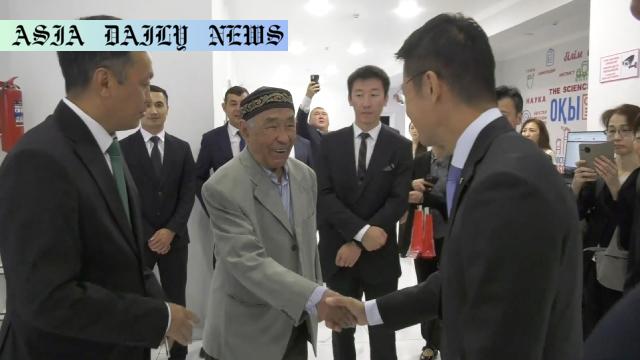Nuclear Testing: Hiroshima Governor seeks global cooperation for nuclear disarmament during his visit to Kazakhstan.
Hiroshima Governor Yuzaki visited Kazakhstan to discuss nuclear disarmament.
More than 450 nuclear tests were conducted in Semipalatinsk, affecting 1.5 million people.
Local Kazakhstan residents suffer ongoing health problems due to radiation.
Yuzaki aims to enhance global cooperation to abolish nuclear weapons.

Governor Yuzaki’s Efforts to End Nuclear Testing
Hiroshima Governor Yuzaki Hidehiko recently concluded a visit to Kazakhstan, a country irrevocably impacted by years of nuclear testing conducted during the Soviet Union’s control. Over a period spanning decades, more than 450 nuclear tests were carried out in Semipalatinsk, also referred to as the Polygon. These catastrophic experiments have left behind long-lasting consequences for both the environment and the livelihoods of local communities. Yuzaki, representing a city that suffered the horrors of nuclear weapons 80 years ago, aimed to promote international cooperation toward global nuclear disarmament during his visit.
In a conversation with NHK, Governor Yuzaki indicated the enduring damage nuclear tests have caused in areas such as Kazakhstan. Drawing parallels with Hiroshima and Nagasaki, he emphasized the urgent need to eliminate nuclear threats. He also highlighted the human cost of nuclear testing, giving voice to survivors who continue to grapple with devastating radiation-related health conditions decades after exposure.
Stories of Suffering: The Aftermath of Semipalatinsk
During his time in Kazakhstan, Yuzaki met with Argynbek Akhmetjanov, a resident who lived a mere 40 kilometers away from the infamous Semipalatinsk testing site. Akhmetjanov recalled the naïve perception he had as a child, mistaking the dangerous mushroom clouds for a form of entertainment. Such sentiments underscore the lack of awareness among locals during the era of testing. Nevertheless, the impacts of these operations have been far from harmless. Akhmetjanov currently suffers from severe health issues, including persistent stomach pain, attributed to radiation exposure.
The trauma, however, does not end with the initial victims. Research conducted by a local medical university reveals that subsequent generations in Semipalatinsk continue to experience medical complications potentially linked to radiation exposure. This intergenerational toll demonstrates the profound and far-reaching impacts nuclear testing has on society. Experts estimate that approximately 1.5 million people have been affected as a result of the Soviet Union’s nuclear program in this region.
A Global Call for Nuclear Disarmament
Governor Yuzaki’s visit to Kazakhstan serves as a critical reminder of the necessity of international solidarity to address nuclear issues. The governor’s passionate advocacy for nuclear disarmament emphasizes the human cost associated with maintaining stockpiles of such destructive weapons. By fostering partnerships with nations such as Kazakhstan, Yuzaki hopes to create a unified global front against the continued development and use of nuclear arms.
Hiroshima, as a living testament to the catastrophic impact of nuclear weaponry, serves as a powerful symbol of the disastrous consequences of atomic warfare. Through dialogue and collaboration, leaders like Yuzaki aim to encourage political entities, organizations, and citizens worldwide to take decisive action to eliminate nuclear threats, ensuring a safer future for all generations.
Conclusion
As Governor Yuzaki continues his quest to build alliances for nuclear disarmament, the voices of people like Argynbek Akhmetjanov should not go unheard. Their experiences stand as a stark reminder that nuclear weapons leave irreversible damage on humanity and the environment. By fostering connections between communities and global leaders, Hiroshima’s appeal for a nuclear-weapon-free world sets an admirable path forward—one guided by empathy, resilience, and a shared commitment to peace.
Commentary
Perspective on the Global Consequences of Nuclear Testing
The recent initiatives by Hiroshima Governor Yuzaki Hidehiko spark a necessary and urgent conversation about the global consequences of nuclear testing. Over eighty years after the atomic bombings of Hiroshima and Nagasaki, the scars of such destruction weigh heavily as nations like Kazakhstan continue to grapple with the repercussions of nuclear experimentation. Efforts like Yuzaki’s are a poignant reminder that humanity must reconcile with its past mistakes to ensure a brighter, safer future free from nuclear threats.
The Enduring Legacy of Semipalatinsk
The devastating impact of nuclear testing in Kazakhstan is a tragic legacy of the Cold War. Meeting individuals like Argynbek Akhmetjanov brings to light the profound suffering endured by victims of radiation exposure. His story reflects a broader narrative of negligence during the era of nuclear arms development, where local communities often bore the weight of geopolitical decisions far outside their control. The startling number—1.5 million people affected—is an unimaginable testament to the scale of these human-made disasters.
Learning from History to Shape the Future
Yuzaki’s visit underscores the interconnected nature of global efforts toward peace and disarmament. Building connections between Hiroshima, a city that symbolizes resilience, and Semipalatinsk serves as a powerful gesture of unity. Such initiatives emphasize the universality of the message against nuclear armament: no region or nation is immune to its devastating effects. As the world faces pressing challenges such as climate change and geopolitical instability, eliminating nuclear weapons should remain a top priority for world leaders.


